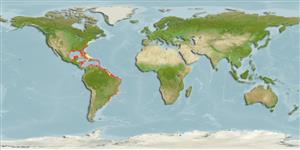Environment: milieu / climate zone / depth range / distribution range
Ekologi
laut berasosiasi dengan karang; kisaran kedalaman 1 - 80 m (Ref. 5217). Subtropical; 42°N - 35°S, 98°W - 28°W
Western Atlantic: North Carolina, USA, the northern Gulf of Mexico and the Bahamas southward to Uruguay. Occurrence in western Caribbean is doubtful (Ref. 26938).
Length at first maturity / Size / Weight / umur
Maturity: Lm 12.9 range ? - ? cm
Max length : 30.0 cm TL jantan/; (Ref. 7251); common length : 16.0 cm TL jantan/; (Ref. 5217)
Duri punggung (Keseluruhan (total)): 10; duri punggung lunak (Keseluruhan (total)): 12; Duri dubur 3; Sirip dubur lunak: 7 - 8. Body pale brown dorsally with several vertical dark brown bars, becoming white ventrally; dorsal fin dusky with longitudinal yellow lines; pectoral, pelvic and anal fins dusky; caudal fin dusky with small yellow blotches (Ref. 13608). Preopercle has spines radiating from 2 centers (Ref. 26938).
Inhabits bays, coastal grassy areas and shallow banks. Solitary (Ref. 26340) and retreats into shelter when frightened (Ref. 9710). Neither opercular spine nor anterolateral glandular grooves with venom gland is present (Ref. 57406). Synchronously hermaphroditic. Popular as a pan fish despite its small size.
Simultaenous hermaphrodite. The gonad contains ovarian and testicular tissue separated by a thin basement membrane, with no means of internal self-fertilization.
Robins, C.R. and G.C. Ray, 1986. A field guide to Atlantic coast fishes of North America. Houghton Mifflin Company, Boston, U.S.A. 354 p. (Ref. 7251)
Status IUCN Red List (Ref. 130435)
penggunaan manusia
Perikanan: komersial; Ikan buruan: ya
informasi lanjut
AcuanBudidaya airprofil budidaya airStrainGenetikaElectrophoresesDiturunkanPenyakit-penyakitPengolahanNutrientsMass conversion
mitraGambarStamps, Coins Misc.Suara-suaraCiguateraKecepatanTipe renangArea insangOtolithsOtakPenglihatan / visi
Alat, peralatan
laporan khas
muat turun XML
Sumber internet
Estimates based on models
Preferred temperature (Ref.
123201): 21.9 - 28, mean 25.2 °C (based on 542 cells).
Phylogenetic diversity index (Ref.
82804): PD
50 = 0.5002 [Uniqueness, from 0.5 = low to 2.0 = high].
Bayesian length-weight: a=0.00912 (0.00746 - 0.01115), b=3.10 (3.06 - 3.14), in cm total length, based on LWR estimates for this species (Ref.
93245).
Trophic level (Ref.
69278): 4.5 ±0.0 se; based on diet studies.
Generation time: 3.8 ( na - na) years. Estimated as median ln(3)/K based on 2
growth studies.
Daya lenting (Ref.
120179): Tinggi, Waktu penggandaan populasi minimum kurang dari 15 bulan (K=0.29-1.5; tm=1.01).
Fishing Vulnerability (Ref.
59153): Low vulnerability (15 of 100).
Climate Vulnerability (Ref.
125649): Moderate vulnerability (36 of 100).
Nutrients (Ref.
124155): Calcium = 45.5 [21.2, 110.6] mg/100g; Iron = 0.928 [0.416, 1.865] mg/100g; Protein = 19.6 [17.6, 21.4] %; Omega3 = 0.276 [0.136, 0.546] g/100g; Selenium = 21.5 [9.2, 50.2] μg/100g; VitaminA = 46.5 [12.7, 213.2] μg/100g; Zinc = 0.712 [0.414, 1.183] mg/100g (wet weight);
